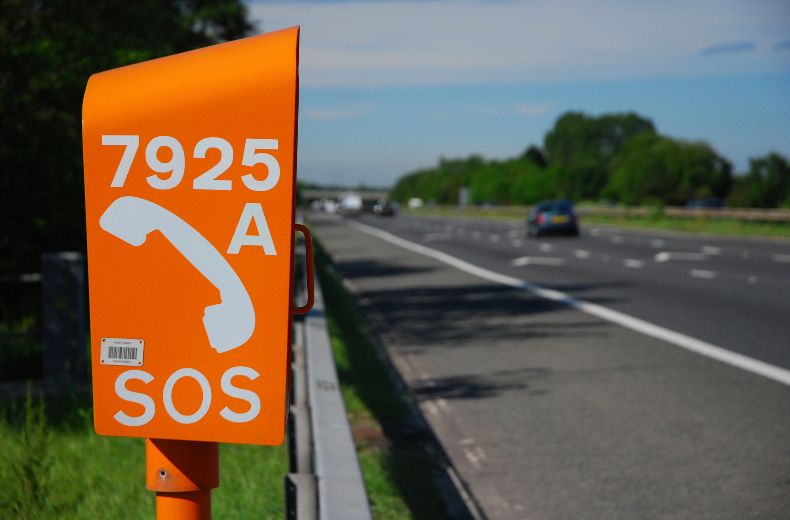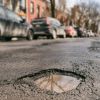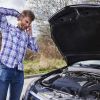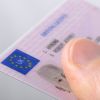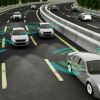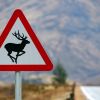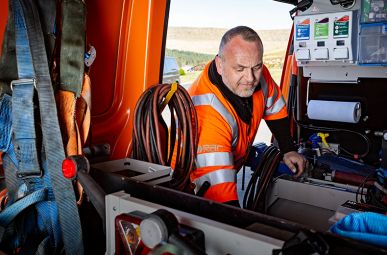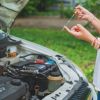We’ve put together an in-depth guide to help you deal with a breakdown, with specific advice for all types of roads in the UK (including motorways and smart motorways). Read on to find out what you should do in the event of a vehicle breakdown.
Where have you broken down? Jump to the right section:
I’ve broken down – what should I do?
1. Stay calm and think of other road user
Try and move your car off the road to get away from other vehicles and ensure your wheels are also turned all the way to the left.
2. Turn your hazard lights on and leave your car by the left hand door
Ensure you’re wearing light-coloured clothes or a hi-vis vest (especially at night or when visibility is low). If visibility is poor or you’re stood waiting for help at night, keep your sidelights switched on and make sure you’re not blocking others from seeing your lights. If you feel unsafe or there is nowhere secure to wait, call the police.
3. Take your warning triangle and place it 45 metres (147 feet) behind your vehicle, that’s about 60 paces.
Don’t do this on a motorway. If it is raining or visibility is poor, keep your sidelights switched on so other road users can see your vehicle. Call the police if where is nowhere safe to wait.
4. Contact your breakdown service
Get breakdown cover here. If you're already an RAC member you can call us, or quickly report a breakdown via our website or the myRAC app.
Check out our breakdown kits from the RAC Shop.
Do not stand, or let your passengers stand, between your car and oncoming traffic.
What to do if you've broken down on a motorway
1. Take your car off the motorway
Try to leave the motorway at the nearest exit or by pulling into a service station.
If this isn’t possible, pull over onto the hard shoulder and stop your car as far to the left as possible with your wheels also turned to the left.
2. Leave your car safely and stand away from traffic
Turn on your hazards and if you’ve broken down at night or visibility is low, use your sidelights too.
Make sure you and your passengers leave the car using the left-hand door, wearing hi-vis jackets if you have them.
Climb over the safety barriers to distance yourself from passing traffic. Wait for help here.
3. Give us a call or report a breakdown online
Members and non-members can call us on 0333 2000 999 to get instant breakdown support.
You can also report a breakdown digitally via our website or the myRAC app.
If you don’t have a mobile phone available, walk to an emergency telephone on your side of the motorway.
Emergency telephones are found roughly one mile apart should you need to use them. Breakdown services can also use these sites as markers to help us locate you more quickly.The emergency telephone service is free of charge.
You should always face traffic when speaking on the phone. And don’t forget to inform the operator if you have any additional needs to be aware of.
Do not…
- attempt any repairs yourself - if you've been rescued from a breakdown and need any repairs, contact a RAC Mobile Mechanic or search for a RAC Approved Garage to carry out any required work.
- place a warning triangle anywhere on the motorway, that includes dual carriageways
- stand on the carriageway or stand between your car and other passing vehicles
How to stay safe on a high-speed road

RAC sale – up to 33% off*
• Roadside cover from £5.29 a month†
• We get to most breakdowns in 60 mins or less
• Our patrols fix 4/5 breakdowns on the spot

Broken down on a motorway and can’t get to the hard shoulder
- Try to get into the leftmost lane and as far off the carriageway as possible
- Keep your seatbelt fastened and switch on your hazard lights
- Get out of the car only if you can safely get clear of the carriageway
- Do not attempt to place a warning triangle
- Call 999 first
- Then contact us
If you can’t get to the leftmost lane, stay in your car with your seatbelt and hazard lights on, then call 999.
If you’re disabled and unable to follow advice about leaving the car, also stay in your car with your seatbelt and hazard lights on, then call 999.
Broken down on a smart motorway
Your car may break down on a smart motorway without a hard shoulder. If you break down on one of these roads you should:
1. Try to take your car off the motorway
Move to the left-hand lane with your hazard lights on, then exit the motorway at the nearest junction, service station, or emergency refuge area – you can find these safe sections of road by following orange SOS signs.
2. Leave your car safely and stand away from traffic
Turn on your hazards and if you’ve broken down at night or visibility is low, use your sidelights too.
Make sure you and your passengers leave the car using the left-hand door, wearing hi-vis jackets if you have them.
Climb over the safety barriers to distance yourself from passing traffic. Wait for help here.
3. Use the emergency phone service
You MUST use the emergency telephone found in the emergency refuge area and give as much information to the operator as you can.
You can ask the highways agency to contact the RAC on your behalf.
When you’ve completed the call, stand behind the emergency barrier.
Do not…
- attempt any repairs yourself
- place a warning triangle anywhere on the motorway, including the dual carriageway
- stand on the carriageway, or between your car and other passing vehicles
Smart motorways – what are they and how do you use them? Video guide
Broken down on a smart motorway and can’t get to an emergency refuge area
- Try moving your car as far over to the left-hand verge as possible.
- Only if it’s safe to do so, leave the car along with your passengers using the left-hand door and wait behind any safety barriers.
- Call 999 immediately.
IMPORTANT – If your car unexpectedly stops in a lane away from the verge, do not attempt to get out.
Keep your seatbelts and hazards on and call 999 immediately.
Broken down?
Get breakdown cover or call for recovery if you’re already an RAC member.


What to do if your car breaks down on a country road?
If your car breaks down on a country lane, don’t panic, take these steps to ensure your safety.
Should you find yourself in this situation, turn on hazard lights, pull over as far as possible, and exit the vehicle when safe to do so.
Following this, place a warning triangle 30 to 45 meters behind your car.
If there is somewhere where you can stand off the road, position yourself there and put on a high vis jacket.
You are then safe to contact your car breakdown company and request some roadside assistance.
After you’ve spoken to the breakdown cover provider, wait in a safe place and do not attempt repairs unless you are experienced mechanic.
If you have any questions for us, leave them in the comments below.
Car breakdown - FAQs
- What do I do if my car has broken down?
If your car has broken down, the most important thing to do is to stay safe. Pull your car off of the road and turn on your hazard warning lights. If you can, call your breakdown provider and organise a mechanic or recovery vehicle
You’ll also need to figure out how to prevent a similar breakdown in the future. Ask your mechanic for advice on what maintenance you should be doing, or consider getting a roadside assistance plan if you do not have one.
- Can you leave your car if broken down?
If you have broken down on a public road or highway, you may be required to call for roadside assistance or towing services to move your car, as leaving it unattended is not allowed. In this case, you may also be subject to a fine or other penalties, depending on your location.
If you have broken down on private property, such as in a parking lot or on your own driveway, you may be able to leave your car while you look into getting it repaired or replaced. However, you should contact the property owner first to ask for permission.
- Do you have to stay with a broken down car?
If you are able to assess the situation and determine that it is safe to stay with the car, then you can wait for roadside assistance to arrive. However, if you feel uncomfortable or unsafe, it is best to call for help and leave the vehicle to be repaired or towed away. You cannot leave a vehicle on the motorway or A road.
- What can I do with a broke down car?
Park in a safe space and call your breakdown provider. Give them all your details and what you may think is wrong with the vehicle. Then either remain in the vehcile, or stand on the other side of the motorway barrier until help comes to fix your vehicle.
Book a glow plugs repair
If your diesel engine is having trouble starting, especially in cold weather, it could be faulty glow plugs. Book an RAC Mobile Mechanic today.



